 W
WThe rufous-tailed babbler is a bird species in the family Sylviidae. It is very closely related to the Paradoxornithidae. It is endemic to central China.
 W
WThe Tarim babbler, also known as the Tarim hill warbler is a species of bird in the genus Rhopophilus. Its relationships are uncertain and it has been placed in the families Cisticolidae, Timaliidae or Sylviidae. It is endemic to China.
 W
WThe blackthroat, also known as the black-throated robin or black-throated blue robin, is a species of bird in the family Muscicapidae. It breeds in north-central China but its wintering grounds are uncertain. It has been recorded as a vagrant in northwest Thailand. Its natural habitat is bamboo thickets within coniferous forest at altitudes of 3000–3,400 metres. It is threatened by habitat loss.
 W
WThe slaty bunting is a species of bird in the family Emberizidae.
 W
WThe silver-throated bushtit or silver-throated tit is a species of bird in the family Aegithalidae. It is widely spread throughout central and eastern China and south towards Yunnan. Its natural habitat is temperate forests.
 W
WThe sooty bushtit is a species of bird in the family Aegithalidae. It is endemic to central China.
 W
WSillem's mountain finch or the tawny-headed mountain finch is a species of rosefinch in the finch family. It is found only in China and was only known from two specimens collected in 1929 from the Aksai Chin area of southern Xinjiang Autonomous Region. In 2012, the bird was photographed 1500 km from the original collection location. This species was originally placed in the genus Leucosticte but a phylogenetic study using mitochondrial DNA sequences published in 2016 found that Sillem's mountain finch was a sister species to the Tibetan rosefinch. The International Ornithological Committee therefore moved Sillem's mountain finch to the genus Carpodacus.
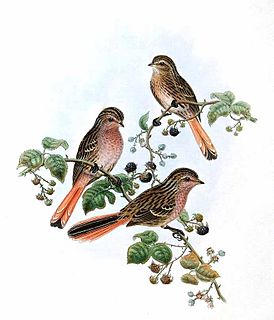 W
WPrzevalski's finch, Przewalski's finch or Przevalski's pinktail, is an unusual passerine bird from the mountains of central-west China. The species is named for Nikolai Przhevalsky, the Russian explorer who described it. Its taxonomic affinities were unclear for a long time, giving rise to other common names, the pink-tailed bunting and the Przewalski's rosefinch. In 2000 it was proposed that it should in fact be regarded neither as a finch nor a bunting, but as the only member of the family Urocynchramidae, something that had been originally proposed in the German ornithological literature as long ago as 1918 by Janusz von Domaniewski, and also by Wolters in 1979. This change was adopted in the sixth edition of the Clements checklist.
 W
WThe grey-hooded fulvetta is a bird species in the family Sylviidae. Like the other typical fulvettas, it was long included in the Timaliidae genus Alcippe.
 W
WThe spectacled fulvetta is a bird species in the family Sylviidae. Like the other typical fulvettas, it was long included in the Timaliidae genus Alcippe.
 W
WThe Chinese grouse, also known as Severtzov's grouse or the black-breasted hazel grouse is a grouse species closely related to the hazel grouse.
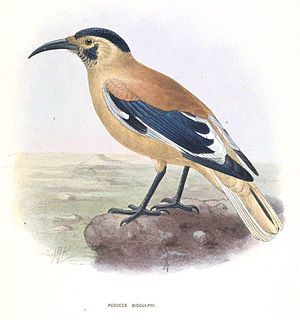 W
WBiddulph's ground jay or the Xinjiang ground jay, is a species of bird in the family Corvidae. It is endemic to China. It is not larger than an adult human's hand and has a brownish white coat of feathers.
 W
WThe Sichuan jay is a species of bird in the family Corvidae. It is endemic to China. It is one of three members of the genus Perisoreus, the others being the Siberian jay, P. infaustus, found from Norway to eastern Russia, and the Canada jay, P. canadensis, restricted to the boreal forest and western montane regions of North America. All three species store food and live year-round on permanent territories in coniferous forests.
 W
WThe barred laughingthrush is a passerine bird in the family Leiothrichidae. It is endemic to central China where its natural habitat is temperate forests.
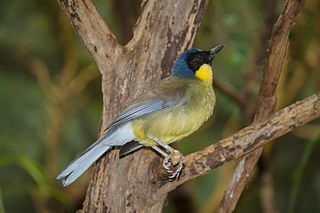 W
WThe blue-crowned laughingthrush or Courtois's laughingbird is a species of bird in the family Leiothrichidae. It is now found only in Jiangxi, China. Until recently, this critically endangered species was generally treated as a subspecies of the yellow-throated laughingthrush, but that species has a pale grey crown.
 W
WThe buffy laughingthrush, also known as the chestnut-winged laughingthrush is a species of bird in the family Leiothrichidae. It is found in the Chinese mainland. It was formerly considered a subspecies of the rusty laughingthrush, P. poecilorhynchus; a species restricted to Taiwan following the split. Compared to the rusty laughingthrush, the buffy laughingthrush has paler grey underparts, more contrasting rufous wings, broader white tips to the tail, and distinct black lores.
 W
WThe plain laughingthrush or Père David's laughingthrush is a species of bird in the family Leiothrichidae. It is endemic to central and northeastern China. Its natural habitat is temperate forests.
 W
WThe snowy-cheeked laughingthrush, also known as Sukatschev's laughingthrush, is a species of bird in the family Leiothrichidae. It is endemic to northern China where its natural habitat is temperate forests. It is threatened by habitat loss.
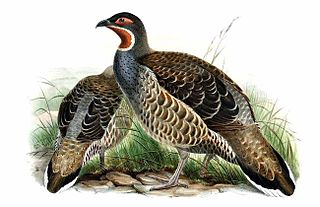 W
WVerreaux's monal-partridge or the chestnut-throated partridge, is a bird species in the family Phasianidae. It is found only in central China. Its natural habitat is boreal forest.
 W
WThe Chinese monal is a pheasant. This monal is restricted to mountains of central China. The plumage is highly iridescent. The male has a large drooping purple crest, a metallic green head, blue bare skin around the eyes, a reddish gold mantle, bluish green feathers and black underparts. The female is dark brown with white on its throat.
 W
WPrzevalski's nuthatch, originally given the nomen nudum "Sitta eckloni", is a bird species in the family Sittidae, collectively known as nuthatches. Long regarded as a subspecies of the white-cheeked nuthatch, it nevertheless differs significantly in morphology and vocalizations. Both S. przewalskii and S. leucopsis have been regarded as closely related to the North American white-breasted nuthatch. It is a medium-sized nuthatch, measuring about 13 cm (5 in) in length. Its upper body is a dark gray-blue or slate color, becoming dark blue-black at the crown. The cheeks and throat are a white buff-orange, turning to a rich cinnamon on the underparts that intensifies in color on the sides of the breast. Vocalizations consist of alternating series of ascending whistles and short notes.
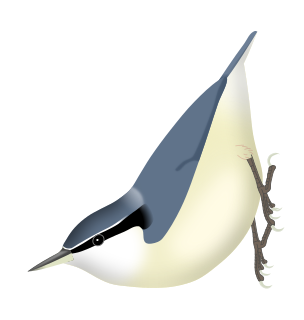 W
WThe Yunnan nuthatch is a species of nuthatch endemic to South-Western China. It was first described by William Robert Ogilvie-Grant in 1900 based on a male holotype, and it occurs in pine forests at altitudes of up to 4,000 m (13,000 ft). It is a small nuthatch, measuring 12 cm in length, without pronounced sexual dimorphism. The upperparts are gray-blue, contrasting with the light, smooth, buffy lowerparts. It has a fine white eyebrow, distinct when the plumage is fresh, and surmounting a pronounced black eye line. It is a noisy bird, producing simple, nasal sounds, sometimes in repetitive series.
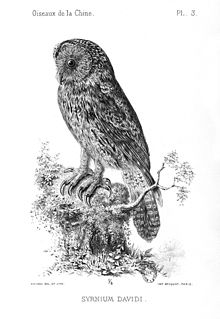 W
WPère David's owl is an owl found in the mountains of central China. There is debate over whether it is a separate species or an isolated subspecies of Ural owl. The Clements Checklist of Birds of the World considers it separate, but BirdLife International and IUCN treat it as a subspecies.
 W
WThe grey-hooded parrotbill is a species of parrotbill in the family Sylviidae. It is endemic to China. Its natural habitats are temperate forests and temperate shrubland. It is threatened by habitat loss.
 W
WPrzevalski's parrotbill or the rusty-throated parrotbill, is a species of parrotbill in the family Sylviidae. It is endemic to a small area of central China. Its natural habitat is temperate forests. It is threatened by habitat loss.
 W
WThe three-toed parrotbill is a species of parrotbill in the family Sylviidae. It is endemic to central China. Its natural habitat is temperate forests.
 W
WThe Hainan partridge is a species of bird in the family Phasianidae. It is endemic to Hainan Island, China. Its natural habitats are primary evergreen forests. It is threatened by habitat loss and has been assessed as a vulnerable species.
 W
WThe white-necklaced partridge, also known as the collared partridge or Rickett's hill-partridge, is a species of bird in the family Phasianidae. It is endemic to southeastern China. It is threatened by habitat loss and hunting, and the IUCN has assessed it as near-threatened.
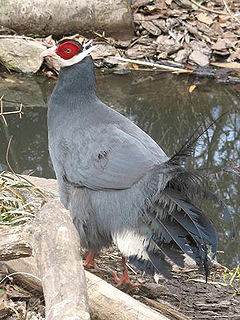 W
WThe blue eared pheasant is a large, up to 96 cm (38 in) long, dark blue-grey pheasant with velvet black crown, red bare facial skin, yellow iris, long white ear coverts behind the eyes, and crimson legs. Its tail of 24 elongated bluish-grey feathers is curved, loose, and dark-tipped. Both sexes are similar with the slightly larger male.
 W
WThe brown eared pheasant is a large, 96– to 100-cm-long, dark brown pheasant endemic to the mountain forests of northeastern China. The species was first described by Robert Swinhoe in 1863. It has stiff white ear coverts behind the eyes, which look like a moustache. The crown is black with red bare facial skin and its tail of twenty-two elongated white feathers is curved, loose and dark-tipped. Both sexes are similar in plumage.
 W
WElliot's pheasant, is a large pheasant native to south-eastern China.
 W
WThe golden pheasant, also known as the Chinese pheasant, and rainbow pheasant, is a gamebird of the order Galliformes and the family Phasianidae (pheasants). The genus name is from Ancient Greek khrusolophos, "with golden crest", and pictus is Latin for "painted" from pingere, "to paint".
 W
WReeves's pheasant is a large pheasant within the genus Syrmaticus. It is endemic to China. It is named after the British naturalist John Reeves, who first introduced live specimens to Europe in 1831.
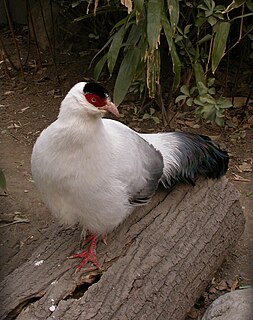 W
WThe white eared pheasant, also known as Bee's pheasant, is a species of "eared pheasant" that get its name because its colouration is white and has the prominent ear tufts of the genus, not because it has white ears. The indigenous people of Himalaya call it shagga, meaning snow fowl. This gregarious bird lives in large flocks, foraging on alpine meadows close to or above the snowline throughout the year. C. crossoptilon is found in China, Qinghai, Sichuan, Yunnan, and Tibet, where it tends to inhabit mixed forests and can be found around Buddhist monasteries.
 W
WPrzevalski's redstart, also known as the Ala Shan redstart, is a species of bird in the family Muscicapidae. It is endemic to China.
 W
WThe rufous-headed robin is a species of passerine bird in the family Muscicapidae. It is found in central China. Its natural habitats are temperate forests and temperate shrubland. This poorly known species is thought to be threatened by habitat loss.
 W
WThe Chinese beautiful rosefinch is a true finch species. It is one of the rosefinches that might belong in the genus Propasser. It is found in China. Its natural habitats are temperate shrubland and subtropical or tropical high-altitude shrubland.
 W
WPère David's tit or the rusty-breasted tit is a species of bird in the tit family Paridae. It is endemic to central China in southern Gansu, western Hubei, southern Shaanxi and Sichuan.
 W
WThe white-browed tit is a species of bird in the tit family Paridae. It is endemic to the mountain forests of central China and Tibet.
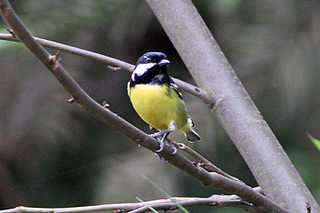 W
WThe yellow-bellied tit is a bird in the family Paridae. The species was first described by Robert Swinhoe in 1870.
 W
WCabot's tragopan is a pheasant found in south-east China. The common and scientific names of this large bird both commemorate the ornithologist Samuel Cabot III. Other common names include the Chinese tragopan and the yellow-bellied tragopan. The population is divided into two subspecies, of which the nominate race is found in the provinces of Fujian, Jiangxi, Zhejiang, and Guangdong, and T. c. guangxiensis is confined to northeastern Guangxi and southern Hunan. The IUCN has assessed it as being a "vulnerable species".
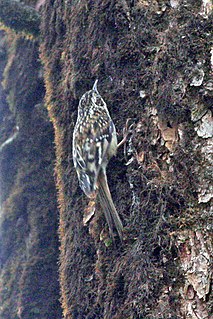 W
WThe Sichuan treecreeper is a rare species of bird in the treecreeper family, Certhiidae.
 W
WClaudia's leaf warbler is a leaf warbler found only in China. Its natural habitat is temperate forests. Most taxonomists previously considered it to be a subspecies of the Blyth's leaf warbler.
 W
WThe Gansu leaf warbler is a small passerine bird known only from China. It belongs to the leaf warbler genus Phylloscopus within the family Phylloscopidae. It was formerly treated as a subspecies of Pallas's warbler but is now regarded as a separate species based on differences in voice and cytochrome-b gene sequences.